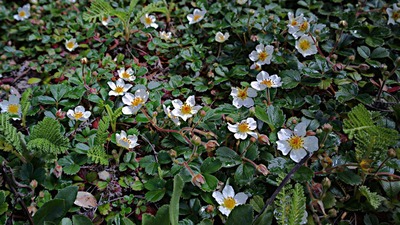Soil erosion is a common challenge, especially on slopes and areas prone to heavy rainfall or wind. It can degrade landscapes, reduce soil fertility, and lead to runoff issues. Fortunately, planting vegetation that helps hold soil together and encourages water retention is a natural way to prevent erosion. Certain plants have robust root systems and dense foliage that protect the soil from being easily washed away. Here are 8 top choices that are effective for erosion control and add beauty to your landscape.
1. Creeping Juniper

Creeping juniper is a hardy, low-growing evergreen shrub known for its spreading habit and dense foliage. It’s low-maintenance, drought-resistant, and thrives in poor soil conditions, making it ideal for areas prone to erosion.
The plant’s extensive, mat-forming root system helps stabilize soil on slopes and reduces erosion effectively. The foliage grows densely, which acts as a barrier to water runoff.
- Planting Tips: Plant creeping juniper on slopes or rocky areas where it will have room to spread. It’s especially effective in regions with full sun exposure.
2. Switchgrass

Switchgrass is a tall, native perennial grass that’s commonly used in prairie restoration and erosion control. It’s tolerant of drought and poor soil and provides food and habitat for wildlife.
With its deep, fibrous root system, switchgrass binds soil particles together, reducing soil displacement. Its height and density help slow down water runoff.
- Planting Tips: Plant switchgrass in areas with moderate slopes or alongside streams and rivers to prevent bank erosion. It performs well in both full sun and partial shade.
3. Creeping Phlox

Known for its vibrant spring blooms, creeping phlox is a low-growing perennial groundcover that adds color to any landscape. It’s a great choice for adding visual interest to slopes while providing erosion control. It’s also low-maintenance once established.
The plant spreads across the ground, creating a thick mat that protects the soil from erosion, especially on smaller slopes or hillsides.
- Planting Tips: Creeping phlox does best in full sun to partial shade and requires well-drained soil. It’s a good option for planting around rocks or on embankments.
4. Red Fescue

Red fescue is a cool-season grass with fine-textured blades, commonly used in turfgrass blends and for erosion control. This grass is drought-tolerant, low-maintenance, and grows well in shaded areas where other plants might struggle.
Its fibrous root system effectively stabilizes the soil, and the grass forms a dense ground cover that prevents soil erosion.
- Planting Tips: Red fescue is ideal for shaded slopes or areas where you want a natural, grassy appearance. It’s adaptable to a variety of soils, making it suitable for many landscapes.
5. Wild Ginger

Wild ginger is a low-growing perennial with heart-shaped leaves that thrives in shaded areas. It is a shade-loving plant that tolerates a wide range of soil types. It’s perfect for stabilizing soil in woodland areas.
Its dense foliage acts as a groundcover, protecting the soil from erosion, especially in shaded, forested landscapes.
- Planting Tips: Plant wild ginger in moist, well-drained soil in shaded or partially shaded areas. It’s ideal for erosion control under trees or in forested settings.
6. Beach Strawberry

Beach strawberry is a spreading groundcover with attractive green foliage and small white flowers, native to coastal areas. It is resilient to salt spray and thrives in sandy soils, making it excellent for coastal or seaside erosion control.
This plant’s runners quickly spread over the ground, covering bare soil and stabilizing it, making it ideal for erosion-prone areas.
- Planting Tips: Plant beach strawberry in full sun to partial shade, and provide plenty of space for it to spread. It’s particularly effective for controlling erosion in sandy or coastal soils.
7. Daylilies

Daylilies are hardy, perennial plants with grass-like foliage and vibrant flowers that bloom in summer. They are incredibly low-maintenance, drought-tolerant, and adapt to a wide range of soil conditions.
The fibrous root system of daylilies creates a strong network that helps hold soil in place, reducing erosion on hillsides and slopes.
- Planting Tips: Use daylilies in areas with full sun to partial shade. They’re well-suited for slopes where their roots will help prevent soil from washing away.
8. Sumac

Sumac is a hardy shrub known for its colorful fall foliage and adaptability to various soil types. It’s drought-tolerant, provides seasonal interest with its vibrant fall colors, and supports local wildlife. It spreads by rhizomes, creating a dense root network that holds the soil together, making it perfect for large, erosion-prone areas.
- Planting Tips: Plant sumac on slopes or embankments in full sun for best results. It’s a great option for large areas where erosion is a major concern.
Additional Tips for Using Plants for Erosion Control
- Group Plants with Complementary Root Structures: Use a combination of groundcovers, grasses, and shrubs to create a multi-layered root system that provides enhanced stability.
- Use Mulch and Groundcovers Together: Mulching around plants can help retain soil moisture and further reduce erosion by minimizing bare spots.
- Consider Native Plants: Natives are well-adapted to the local climate and soil, which often makes them more resilient and effective for erosion control.
- Avoid Plants with Shallow Root Systems: Shallow-rooted plants are less effective at binding soil, so choose plants with fibrous or spreading root systems for better erosion control.